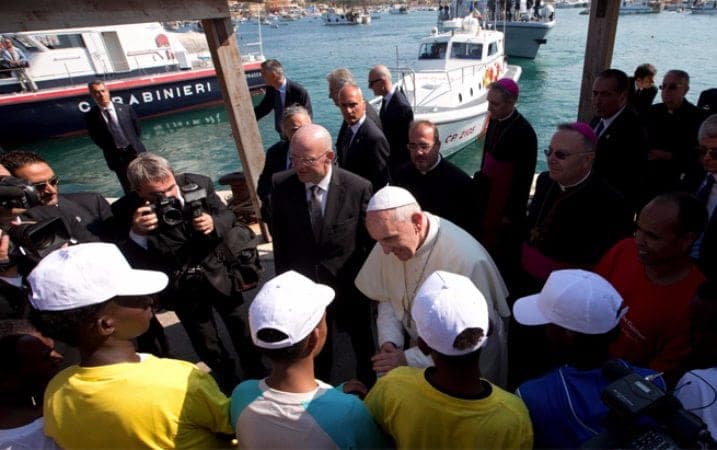ROME – Five years ago this Sunday, Pope Francis left Rome for the first time since his election to travel to the Italian island of Lampedusa. It may have seemed a throw-away outing at the time, but looking back, it’s obvious that it was actually the tone-setting template for absolutely everything that’s followed in terms of Francis and his passionate rejection of a “throw-away” culture.
The pope’s quick day trip, almost forgotten at the time due to the hoopla that surrounded his trip to Brazil for World Youth Day just a few days later, basically contained the entire papacy in miniature, making its five-year anniversary this week an occasion worth commemorating.
Francis will celebrate a special Mass in the Vatican on Friday morning marking the anniversary.
Lampedusa is considered part of Sicily and has been a major point of arrival for migrants and refuges attempting to cross the Mediterranean and reach Europe from Africa and the Middle East.
Usually subjected to appalling exploitation and abuse along the way, migrants try to cross the sea in rickety and overcrowded boats. Some 20,000 people have died that way over the last two decades, and Francis laid a wreath in the sea that July 8 to commemorate them. Shortly before the pope arrived, a boat carrying 165 migrants from Mali pulled into port, while the day he came, 120 people, including four pregnant women, were rescued at sea after the motors in their boat broke down 7 miles off the coast.
On that day, Francis blasted what he called the “globalization of indifference” to migrants, styling them as primary victims of a “throw-away culture.” The visit proved prophetic, as just two weeks later another boatload of migrants from Eritrea, Somalia and Ghana capsized and caught fire, leaving more than 360 people dead.
“Let us ask the Lord to remove the part of Herod that lurks in our hearts,” Francis said that day, referring to the story of the king in the New Testament who ordered infants slaughtered in an effort to strike at the Christ child. “Let us ask the Lord for the grace to weep over our indifference, to weep over the cruelty of our world, of our own hearts, and of all those who in anonymity make social and economic decisions which open the door to tragic situations like this.”
The pope’s leadership has encouraged Church personnel at other levels to ramp up their own efforts. In early April 2014, a delegation of U.S. bishops staged a dramatic pro-immigrant photo-op on the border between the U.S. and Mexico in order to press the case for immigration reform.
Led by Cardinal Sean P. O’Malley of Boston, the bishops cited Francis as the inspiration, saying that Nogales, Arizona, where the Mass took place, is “our Lampedusa.”
As I wrote at the time, one could argue Lampedusa was Francis’s “Victory Square” moment, referring to the famous homecoming of John Paul II to Poland in June 1979 when he stood in downtown Warsaw and inspired three million countrymen to begin chanting, “We want God!” That open defiance of the Communist regime foreshadowed the overall direction of John Paul’s papacy and the impact it would have on the history of his times.
One proof of the impact of Francis’s visit was this: On Christmas Day in 2013, a group of Muslim immigrants from Morocco and Tunisia agreed to suspend a hunger strike in a Rome detention center in exchange for a promise from a local priest to carry a letter from them to the pope. That priest, Father Emanuele Giannone, said that the migrants took the deal because “they saw the images of Francis at Lampedusa, they heard his words that day, and they knew that they came from the heart.”
Just as Victory Square marked John Paul as the pontiff who would stand up to the injustice of the Soviet system, Lampedusa introduced Francis as the pope whose dream of a “poor church for the poor” would be more than rhetoric. It created, in a sense, a framework for his broader advocacy of the social gospel.
Five years later, the jury is decidedly out on how effective Francis has been in mobilizing the Catholic Church in defense of the migrant cause. President Donald Trump in the United States was elected in part on the strength of voicing alarm about the rising immigrant tide, Italy is currently led by a coalition heavily influenced by an explicitly anti-immigrant party, and across Europe populist and sometimes xenophobic movements are enjoying a heyday.
One could actually argue that by being so outspoken, and, in the eyes of some, so confrontational, Francis actually has encouraged opposition and deepened division, making the landscape more rather than less hostile to the migrant cause. At the same time, it’s also worth remembering that Francis has become a hero to migrants all across the world, and many would argue that he’s on the right side of history regardless of the short-term political fallout.
Regardless of the realpolitik of the situation, Francis’s fundamental commitments are abundantly clear. In that sense, March 13, 2013, may have marked the formal opening of his papacy, but July 8 – five years ago this Sunday – signified its substantive beginning.






